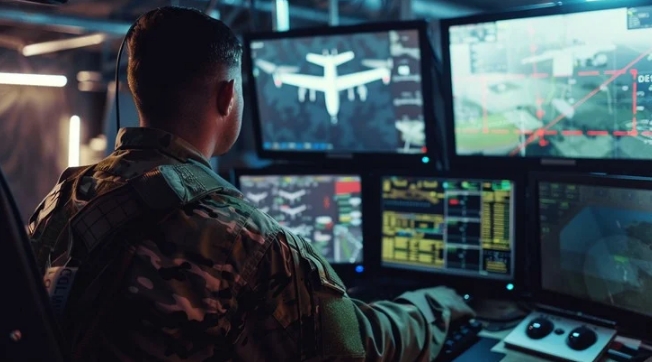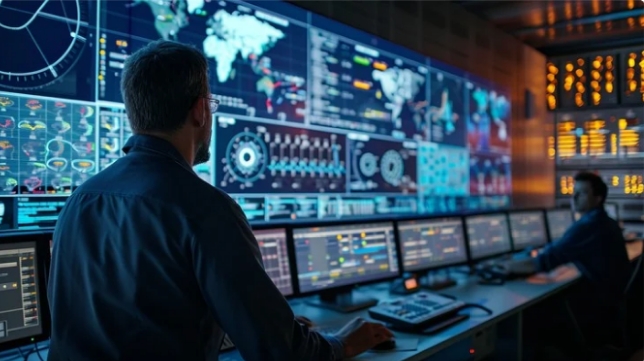In Defense and Aerospace, display systems play a crucial role in providing real-time information, control, and monitoring for complex missions, vehicles, and operations. These displays must meet stringent reliability, security, and performance standards to ensure safety and effectiveness in high-stress, mission-critical environments.

1. High-Resolution Displays
· Clear, Detailed Visualization: Displays must provide clear, high-resolution images to present complex data such as maps, schematics, flight information, or radar imagery. Full HD (1080p), 4K, or higher resolution displays are commonly used in modern systems.
· Wide Viewing Angles: Displays must provide visibility from various angles to ensure that crew members or operators can view the information clearly, regardless of their position.
· Enhanced Contrast and Brightness: Displays are often used in environments with varying lighting conditions, including direct sunlight or in the dark. High brightness (often 1000-2000 nits or more) and high contrast are essential for visibility.
2. Rugged, Military-Grade Construction
· Durability: Displays must be built to withstand harsh environmental conditions, such as vibration, shock, temperature extremes, and humidity. Military and aerospace-grade displays are often built to MIL-STD-810G or similar military standards.
· Impact Resistance: In high-risk environments like combat zones or aircraft cockpits, displays must be resistant to physical impacts, such as drops or blows.
· Waterproof and Dustproof: Many displays in defense and aerospace applications are IP-rated for water and dust resistance (e.g., IP67 or higher).
3. Wide Temperature Range
· Extreme Temperature Tolerance: These displays are often exposed to extreme temperatures, from high heat in desert environments to freezing cold in polar regions. They must operate across a wide temperature range (e.g., -40°C to +85°C).
· Thermal Management: Displays need advanced cooling systems or heat-resistant materials to maintain optimal performance in temperature-sensitive environments, such as inside aircraft or military vehicles.
4. High Brightness & Sunlight Readability
· Anti-Glare and Anti-Reflective Coatings: In aerospace and defense, displays must remain readable even in direct sunlight. Specialized coatings on the display reduce glare and ensure that operators can see the information clearly.
· Sunlight Readable Technology: Displays may use optical bonding, transflective or high-luminance technologies to enhance readability in bright light, providing enhanced contrast even under direct sunlight.
· Adaptive Brightness: Some systems feature adaptive brightness controls that automatically adjust the display’s brightness based on ambient light levels.
5. Touchscreen and Multi-Touch Support
· Interactive Control: Many defense and aerospace systems use touch-sensitive displays to allow operators to interact directly with the system. Touchscreen functionality enables easier control of complex systems without requiring physical buttons or knobs.
· Gloved Operation: Displays may need to work with gloves, especially in military or aerospace environments where operators may wear protective gear. Resistive touchscreens or capacitive touchscreens that are sensitive enough to detect touch even through gloves are commonly used.
· Multi-Touch Capabilities: Multi-touch support can allow operators to manipulate complex interfaces (e.g., zooming in on maps, rotating radar views) using multiple fingers at once.
6. Multiple Video Inputs and Integration
· Integrated Systems: Defense and aerospace displays often integrate multiple systems into one unit. They can display information from various sources, such as radar systems, camera feeds, satellite imagery, or weapon targeting systems.
· Multi-Input Support: These displays typically support multiple input formats, such as HDMI, VGA, DisplayPort, or DVI, as well as specialized video feeds like MIL-STD-1553, Ethernet/IP, or AV over IP.
· Simultaneous Display: Displays often need to show data from multiple sensors or systems simultaneously (e.g., showing flight data, tactical maps, and enemy radar systems in a split-screen format).
7. Customization and Configurability
· Modular Design: Display systems for defense and aerospace can often be customized to meet specific needs. Whether it’s adjusting the layout of the user interface, adding or removing controls, or adapting the display size, these systems are often modular.
· Configurable UI: Operators often need customizable user interfaces that allow them to prioritize information, reassign controls, and choose what data is most important based on the mission or task at hand.
· Interactive Overlays: Displays may include interactive overlays such as maps, tactical grids, or digital overlays on live camera feeds to assist operators in real-time decision-making.
8. Advanced Color and Graphical Rendering
· Night Vision Compatibility: In defense applications, many displays are designed to be compatible with night vision systems. They use special filters or modes that adjust the display’s color scheme to prevent interference with night vision goggles (NVGs) while still presenting clear information.
· High-Quality Graphics Rendering: For more advanced applications like UAV (Unmanned Aerial Vehicle) control or combat aircraft, the display must support high-definition graphics rendering for clear, real-time visualizations of complex data, such as 3D mapping, targeting systems, and flight data.
9. Low Latency and Real-Time Data Display
· Fast Data Processing: Defense and aerospace displays require real-time data processing and low latency. In high-pressure environments like fighter jets or mission control, even a slight delay can make a difference.
· Fast Refresh Rates: High refresh rates (e.g., 60Hz, 120Hz, or 240Hz) are essential in environments where quick movement or high-speed data updates (e.g., radar tracking or aircraft speed) need to be displayed in real-time.
10. Secure Data Transmission
· Encryption and Security: Security is a major concern in defense and aerospace applications. Displays may need to comply with strict cybersecurity standards, such as military-grade encryption for communication and data transmission.
· Data Protection: Systems often need features like secure boot, hardware-based encryption, and anti-tampering measures to protect sensitive information and ensure that data remains secure even in the event of a cyberattack.
11. Integration with Control Systems
· Command and Control Systems: Displays are integral parts of command and control (C2) systems, which aggregate and present critical information for decision-makers, such as tactical data, satellite imagery, or combat reports.
· Automation and AI Support: Some displays are integrated with artificial intelligence or automated systems that help to process large amounts of data and highlight key insights, making it easier for military or aerospace personnel to make quick, informed decisions.
12. Environmental Protection
· MIL-STD-810F/G: Many defense and aerospace displays are built to meet MIL-STD-810 standards, ensuring that the equipment is resilient to environmental factors such as salt fog, humidity, vibration, and shock.
· IP Rating: Displays may be rated to IP65 or higher (dustproof and water-resistant), ensuring that they function reliably in rugged outdoor environments or aircraft cabins.
Common Applications of Defense & Aerospace Displays:

1. Military Vehicles: Displays are used for controlling and monitoring systems in armored vehicles, tanks, and command centers.
2. Cockpit Displays: In fighter jets, helicopters, and commercial aircraft, displays provide flight data, navigation, system health, and tactical information.
3. UAVs (Unmanned Aerial Vehicles): Displays are used for controlling and monitoring UAVs, showing critical flight data, camera feeds, and target identification.
4. Command and Control Centers: These displays aggregate data from various sensors and systems, providing military personnel with a unified view of battlefield conditions or mission status.
5. Satellite Operations: In space missions, displays monitor satellite systems, track movement, and provide real-time telemetry data to mission controllers.
Conclusion:
Defense and Aerospace display systems must combine robust, high-performance features with extreme durability to meet the needs of operators in high-stress environments. They enable quick decision-making, clear situational awareness, and efficient control of complex systems, making them essential in modern military and aerospace operations. Whether for cockpit management, command centers, or unmanned systems, these displays need to be designed for real-time interaction, high visibility, and environmental resilience.
Defense & Aerospace Display Custom LCD Solutions for Diverse Applications
Brightness from 0-3000 for perfect display effect achievement. 100% NTSC makes the vividness of the picture better and the color transition in the picture more natural.
Color Temperature is positive white at around 5500K, warm white (yellowish) at 3500K and also cool white (cold) at 6500K.
Driver circuit with sufficient voltage and current values to meet output requirements and reduce the secondary development cycle.
Heat dissipation for high-brightness products to advance design of reasonable heat dissipation structure.
Power consumption, we increase the brightness without increasing the power consumption.
Cables, Backlighting also requires cables, either through an FPC connected to the LCD's FPC and controlled through a port, or a separate cable that controls it through a connector.LED life reached the standard of 30K hours Min. 50K, 70K, 100K hours are all achievable.

Defense & Aerospace Display Touch screen,standard type and customization 
Defense & Aerospace Display Driver board/adapter board, standard type and design customization
DEMO board, H-DMl board, other customized board, etc.

Defense & Aerospace Display Embedded Integrated Solution
UART display solution, H-DMl display solution, Window display solution, Android display solution, Raspberry Pi solution, portable secondary screen solution, etc.